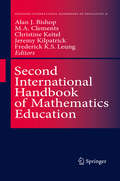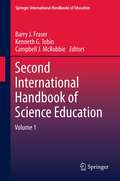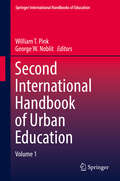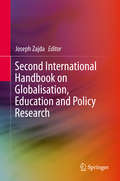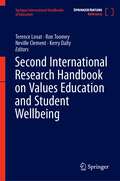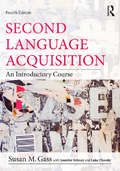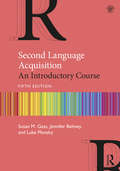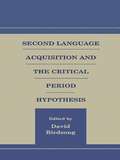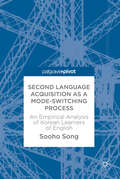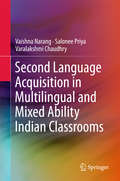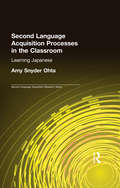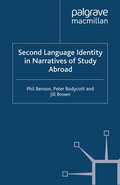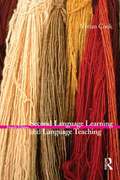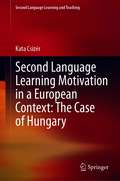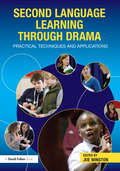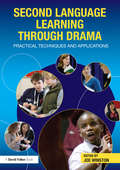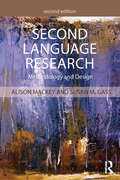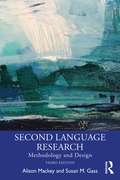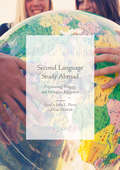- Table View
- List View
Second International Handbook of Mathematics Education (Springer International Handbooks of Education #10)
by Alan J. BishopALAN 1. BISHOP The first International Handbook on Mathematics Education was published by Kluwer Academic Publishers in 1996. However, most of the writing for that handbook was done in 1995 and generally reflected the main research and development foci prior to 1994. There were four sections, 36 chapters, and some 150 people contributed to the final volume either as author, reviewer, editor, or critical friend. The task was a monumental one, attempting to cover the major research and practice developments in the international field of mathematics education as it appeared to the contributors in 1995. Inevitably there were certain omissions, some developments were only starting to emerge, and some literatures were only sketchy and speculative. However that Handbook has had to be reprinted three times, so it clearly fulfilled a need and I personally hope that it lived up to what I wrote in its Introduction: The Handbook thus attempts not merely to present a description of the international 'state-of-the-field', but also to offer synthetic and reflective overviews on the different directions being taken by the field, on the gaps existing in our present knowledge, on the current problems being faced, and on the future possibilities for development. (Bishop et aI. , 1996) Since that time there has been even more activity in our field, and now seems a good time to take stock again, to reflect on what has happened since 1995, and to create a second Handbook with the same overall goals.
Second International Handbook of Science Education (Springer International Handbooks of Education #24)
by Barry J. Fraser, Kenneth Tobin and Campbell J. McRobbieThe International Handbook of Science Education is a two volume edition pertaining to the most significant issues in science education. It is a follow-up to the first Handbook, published in 1998, which is seen as the most authoritative resource ever produced in science education. The chapters in this edition are reviews of research in science education and retain the strong international flavor of the project. It covers the diverse theories and methods that have been a foundation for science education and continue to characterize this field.Each section contains a lead chapter that provides an overview and synthesis of the field and related chapters that provide a narrower focus on research and current thinking on the key issues in that field. Leading researchers from around the world have participated as authors and consultants to produce a resource that is comprehensive, detailed and up to date. The chapters provide the most recent and advanced thinking in science education making the Handbook again the most authoritative resource in science education.
Second International Handbook of Urban Education (Springer International Handbooks of Education)
by William T. Pink George W. NoblitThis second handbook offers all new content in which readers will find a thoughtful and measured interrogation of significant contemporary thinking and practice in urban education. Each chapter reflects contemporary cutting-edge issues in urban education as defined by their local context. One important theme that runs throughout this handbook is how urban is defined, and under what conditions the marginalized are served by the schools they attend. Schooling continues to hold a special place both as a means to achieve social mobility and as a mechanism for supporting the economy of nations. This second handbook focuses on factors such as social stratification, segmentation, segregation, racialization, urbanization, class formation and maintenance, and patriarchy. The central concern is to explore how equity plays out for those traditionally marginalized in urban schools in different locations around the globe. Researchers will find an analysis framework that will make the current practice and outcomes of urban education, and their alternatives, more transparent, and in turn this will lead to solutions that can help improve the life-options for students historically underserved by urban schools.
Second International Handbook on Globalisation, Education and Policy Research
by Joseph ZajdaThis handbook presents a global overview of developments in education and policy change during the last decade. It provides an accessible, practical and comparative source of current research that examines the intersecting and diverse discourses of this important issue.Divided into two parts, the handbook first examines globalisation and education policy reforms, including coverage of main trends as well as specific policy issues such as gender, equity, minorities and human rights. Next, the handbook offers a comparative perspective that evaluates the ambivalent and problematic relationship between globalisation, the state and education reforms globally. It features coverage on curricula issues and education reforms in schools around the world as well as the curriculum in the global culture.Now more than ever there is a need to understand and analyse both the intended and the unintended effects of globalisation on economic competitiveness, educational systems, the state and relevant policy changes--all as they affect individuals, the higher education sector, schools, policy-makers and powerful corporate organisations across the globe. By examining some of the major education policy issues, particularly in the light of recent shifts in education and policy research, this handbook offers readers a comprehensive picture of the impact of globalisation on education policy and reforms. It will serve as a vital sourcebook of ideas for researchers, practitioners and policy makers in education.
Second International Research Handbook on Values Education and Student Wellbeing (Springer International Handbooks Of Education Ser.)
by Terence Lovat Ron Toomey Neville Clement Kerry DallySecond Language Acquisition: An Introductory Course
by Susan M. GassNow in a fourth edition, this bestselling introductory textbook remains the cornerstone volume for the study of second language acquisition (SLA). Its chapters have been fully updated, and reorganized where appropriate, to provide a comprehensive yet accessible overview of the field and its related disciplines. To reflect current developments, new sections on using learner corpora, semantics and morphosyntax (within formal approaches to SLA), sociocultural approaches, gesture, priming research, and chaos theory have been added. Students will also find expanded discussions of heritage language learning, bilingualism, pragmatics, and much more. The redesigned fourth edition of Second Language Acquisition retains the features that students found useful in the current edition but also provides new pedagogical tools that encourage students to reflect upon the experiences of second language learners. As with previous editions, discussion questions and problems at the end of each chapter help students apply their knowledge, and a glossary defines and reinforces must-know terminology. This clearly-written, comprehensive, and current textbook, by expert Sue Gass, is the ideal textbook for the introductory SLA course in second language studies, applied linguistics, linguistics, TESOL, and language education programs.
Second Language Acquisition: An Introductory Course
by Susan M. GassNow in a fourth edition, this bestselling introductory textbook remains the cornerstone volume for the study of second language acquisition (SLA). Its chapters have been fully updated, and reorganized where appropriate, to provide a comprehensive yet accessible overview of the field and its related disciplines. To reflect current developments, new sections on using learner corpora, semantics and morphosyntax (within formal approaches to SLA), sociocultural approaches, gesture, priming research, and chaos theory have been added. Students will also find expanded discussions of heritage language learning, bilingualism, pragmatics, and much more. The redesigned fourth edition of Second Language Acquisition retains the features that students found useful in the current edition but also provides new pedagogical tools that encourage students to reflect upon the experiences of second language learners. As with previous editions, discussion questions and problems at the end of each chapter help students apply their knowledge, and a glossary defines and reinforces must-know terminology. This clearly-written, comprehensive, and current textbook, by expert Sue Gass, is the ideal textbook for the introductory SLA course in second language studies, applied linguistics, linguistics, TESOL, and language education programs.
Second Language Acquisition: An Introductory Course
by Susan M. Gass Jennifer Behney Luke PlonskyNow in a fifth edition, this bestselling introductory textbook remains the cornerstone volume for the study of second language acquisition (SLA). Its chapters have been fully updated, and reorganized where appropriate, to provide a comprehensive yet accessible overview of the field and its related disciplines. In order to reflect current developments, new sections and expanded discussions have been added. The fifth edition of Second Language Acquisition retains the features that students found useful in previous editions. This edition provides pedagogical tools that encourage students to reflect upon the experiences of second language learners. As with previous editions, discussion questions and problems at the end of each chapter help students apply their knowledge, and a glossary defines and reinforces must-know terminology. This clearly written, comprehensive, and current textbook, by Susan Gass, Jennifer Behney, and Luke Plonsky, is the ideal textbook for an introductory SLA course in second language studies, applied linguistics, linguistics, TESOL, and/or language education programs.
Second Language Acquisition and the Critical Period Hypothesis (Second Language Acquisition Research Series)
by David BirdsongSecond Language Acquisition and the Critical Period Hypothesis is the only book on the market to provide a diverse collection of perspectives, from experienced researchers, on the role of the Critical Period Hypothesis in second language acquisition. It is widely believed that age effects in both first and second language acquisition are developmental in nature, with native levels of attainment in both to be though possible only if learning began before the closure of a "window of opportunity" – a critical or sensitive period. These seven chapters explore this idea at length, with each contribution acting as an authoritative look at various domains of inquiry in second language acquisition, including syntax, morphology, phonetics/phonology, Universal Grammar, and neurofunctional factors. By presenting readers with an evenly-balanced take on the topic with viewpoints both for and against the Critical Period Hypothesis, this book is the ideal guide to understanding this critical body of research in SLA, for students and researchers in Applied Linguistics and Second Language Acquisition.
Second Language Acquisition and the Critical Period Hypothesis (Second Language Acquisition Research Series)
by David BirdsongSecond Language Acquisition and the Critical Period Hypothesis is the only book on the market to provide a diverse collection of perspectives, from experienced researchers, on the role of the Critical Period Hypothesis in second language acquisition. It is widely believed that age effects in both first and second language acquisition are developmental in nature, with native levels of attainment in both to be though possible only if learning began before the closure of a "window of opportunity" – a critical or sensitive period. These seven chapters explore this idea at length, with each contribution acting as an authoritative look at various domains of inquiry in second language acquisition, including syntax, morphology, phonetics/phonology, Universal Grammar, and neurofunctional factors. By presenting readers with an evenly-balanced take on the topic with viewpoints both for and against the Critical Period Hypothesis, this book is the ideal guide to understanding this critical body of research in SLA, for students and researchers in Applied Linguistics and Second Language Acquisition.
Second Language Acquisition as a Mode-Switching Process: An Empirical Analysis of Korean Learners of English
by Sooho SongThis book analyses processes of mode-switching in second language acquisition as they relate to Korean learners of English. In this empirical study, the author examines how native language influences and shapes usage of second language, particularly when the two are so dramatically different both in terms of grammar and the cultures in which they are anchored. Learning to speak English, she argues, entails switching from the formulaic to the strategic mode so that varying speaking norms and linguistic values are fully understood. This results in a mode switch towards the target culture. This intriguing book will be of interest to students and scholars of applied linguistics, sociolinguistics and English language education.
Second Language Acquisition in Multilingual and Mixed Ability Indian Classrooms
by Vaishna Narang Salonee Priya Varalakshmi ChaudhryThis book discusses current research on learning theories and pedagogical practices in second language acquisition, and tries to bridge the gap between the two. Second language acquisition is perceived as the study of the relationship between input, intake and output in a particular task performance, and Indian classrooms are the context for the research studies in this book. The empirical studies discussed in this book are based on two tasks: seminar speech task (SST) and written test performance task (WTPT). The pedagogical practices discussed cover three specific areas: tasks, skills, and strategies. The study focuses on text input processing for written versus spoken tasks, at various levels of task performance, and for language versus information. The authors discuss, among other issues, various elements of second language speech production, teachers’ evaluation of communicative versus form-focused tasks, and task-based versus proficiency-based performance. As a study located in multilingual and mixed ability classrooms, this work provides immense insights to teacher-educators and researchers working in ESL settings with learners from diverse backgrounds.
Second Language Acquisition Processes in the Classroom: Learning Japanese (Second Language Acquisition Research Series)
by Amy Snyder OhtaThis book is the first study to examine how interactional style develops within the walls of a foreign language classroom in the first two years of language study. Results show learners to be highly sensitive to pragmatic information and that learners can move toward an appropriate interactional style through classroom interactive experience. The book shows how learners are most often sources who offer assistance and correction, with errors serving most often to stimulate further thinking about what form is correct. Analysis shows learners to be active in seeking corrective information in the classroom setting, not only from peer partners but also from the teacher. They are active in noticing how the teacher's utterances--even when addressed to others--contrast with their own, and utilize corrective feedback intended for other students. In addition, the results show that teacher-initiated corrective feedback addressed to individual learners is only one source of corrective feedback. Learners are shown to be active in both teacher-fronted and peer interactive settings. In newer L2 teaching methodologies which focus on the use of peer interactive tasks, the teacher's role has been de-emphasized. This book, however, shows how important the teacher's role is. The final chapter examines how the teacher can act to maximize the benefits of peer interactive tasks through how they design tasks and present them to the class. First, the chapter looks at how learners use English--their L1--in the classroom, concluding that how teachers present activities to the class has an impact on the amount of L1 used by students during peer interaction. Following up on this finding, the chapter works to address questions that teachers face in lesson planning and teaching. It presents a useful list of questions teachers can ask when designing peer interactive tasks in order to maximize the effectiveness of a wide variety of language learning tasks.
Second Language Acquisition Processes in the Classroom: Learning Japanese (Second Language Acquisition Research Series)
by Amy Snyder OhtaThis book is the first study to examine how interactional style develops within the walls of a foreign language classroom in the first two years of language study. Results show learners to be highly sensitive to pragmatic information and that learners can move toward an appropriate interactional style through classroom interactive experience. The book shows how learners are most often sources who offer assistance and correction, with errors serving most often to stimulate further thinking about what form is correct. Analysis shows learners to be active in seeking corrective information in the classroom setting, not only from peer partners but also from the teacher. They are active in noticing how the teacher's utterances--even when addressed to others--contrast with their own, and utilize corrective feedback intended for other students. In addition, the results show that teacher-initiated corrective feedback addressed to individual learners is only one source of corrective feedback. Learners are shown to be active in both teacher-fronted and peer interactive settings. In newer L2 teaching methodologies which focus on the use of peer interactive tasks, the teacher's role has been de-emphasized. This book, however, shows how important the teacher's role is. The final chapter examines how the teacher can act to maximize the benefits of peer interactive tasks through how they design tasks and present them to the class. First, the chapter looks at how learners use English--their L1--in the classroom, concluding that how teachers present activities to the class has an impact on the amount of L1 used by students during peer interaction. Following up on this finding, the chapter works to address questions that teachers face in lesson planning and teaching. It presents a useful list of questions teachers can ask when designing peer interactive tasks in order to maximize the effectiveness of a wide variety of language learning tasks.
Second Language Identity in Narratives of Study Abroad
by P. Benson G. Barkhuizen P. Bodycott J. BrownStudy abroad is now both an international industry and an experience that can have a deep impact on students' attitudes and approaches to second language learning. Narratives of Second Language Identity in Study Abroad brings together three important research areas by exploring the impact of study abroad on second language identities through narrative research. It outlines a new model of second language identity that incorporates a range of language and personal competencies. The three main dimensions of this model are explored in chapters that begin with students' study abroad narratives, followed by the authors' in-depth analysis. Further chapters use narratives to assess the impact of programme type and individual difference. Arguing that second language identity development is one of the more important outcomes of study abroad, the book concludes with recommendations on how study abroad programmes can best achieve this outcome.
Second Language Learning And Language Teaching (PDF)
by Vivian CookThe fourth edition of this classic textbook has been revised to reflect recent developments in language teaching and learning yet retains the basic structure and approach so popular with its readers. Teaching and learning content has been updated, particularly taking into account the rise of task-based learning, Conversational Analysis and social models of second language acquisition, changes in national syllabuses and examinations and the increasing controversy over the role of the native speaker target. Each chapter has been revised to stand alone, enabling the text to be taught and studied out of sequence if preferred. A set of focussing questions has also been added to each and further reading sections have been updated. In addition, icons appear throughout the text signalling where extra information - summaries, data, lecture notes, test batteries and more - can be found on the author's accompanying website, www. routledge. com/cw/cook. Second Language Learning and Language Teachingremains the essential textbook for all student teachers of modern languages and TESOL as well as applied linguistics.
Second Language Learning Motivation in a European Context: The Case of Hungary (Second Language Learning and Teaching)
by Kata CsizérThis book provides an overview of second language (L2) motivation research in a specific European context: Hungary, which has proved to offer an important laboratory for such research, as a number of major political changes over the past 30 years have created a changing background for L2 learning in an increasingly globalized world. The book provides an overview of theoretical research on L2 motivation, together with detailed information on large-scale L2 motivation studies in Hungary. Further, it presents a meta-analysis of the most important investigations, and qualitative data on teachers’ views regarding success in L2 learning. In turn, the interdisciplinary nature of L2 motivation is taken into account and relevant antecedent constructs to L2 motivation are investigated. Lastly, the book outlines possible future directions for L2 motivation research.
Second Language Learning through Drama: Practical Techniques and Applications
by Joe WinstonDrama is increasingly being recognised as a valuable pedagogy for language learning as it can harness children‘s imaginations and stimulate their desire to communicate. Second Learning Language through Drama draws on current theories of additional and foreign language learning and illustrates through practical case studies how drama can be used to support the four key skills of listening, speaking, reading and writing. Drawing on the work of an international group of practitioners who are all highly experienced in using drama for the purpose of second language learning, the book clearly explains key drama conventions and strategies and outlines the innovative ways they have been used to create enjoyable and stimulating classroom activities that allow for multiple ways of learning. Throughout the book the emphasis is on making language learning accessible and relevant to children and young people through creative, physically active and playful approaches. The strategies described are all highly flexible and readily adaptable to different teaching contexts. Specific themes include: Using stories and drama to motivate learners at all levels Drama, language learning and identity Assessment opportunities through process drama Issues of language learning and cultural empowerment Digital storytelling Film & drama aesthetics Second Language Learning through Drama will be of great interest to those studying on undergraduate and postgraduate courses and will serve as a highly valuable text to practitioners looking to incorporate the approaches described into their lessons and classroom activities.
Second Language Learning through Drama: Practical Techniques and Applications
by Joe WinstonDrama is increasingly being recognised as a valuable pedagogy for language learning as it can harness children‘s imaginations and stimulate their desire to communicate. Second Learning Language through Drama draws on current theories of additional and foreign language learning and illustrates through practical case studies how drama can be used to support the four key skills of listening, speaking, reading and writing. Drawing on the work of an international group of practitioners who are all highly experienced in using drama for the purpose of second language learning, the book clearly explains key drama conventions and strategies and outlines the innovative ways they have been used to create enjoyable and stimulating classroom activities that allow for multiple ways of learning. Throughout the book the emphasis is on making language learning accessible and relevant to children and young people through creative, physically active and playful approaches. The strategies described are all highly flexible and readily adaptable to different teaching contexts. Specific themes include: Using stories and drama to motivate learners at all levels Drama, language learning and identity Assessment opportunities through process drama Issues of language learning and cultural empowerment Digital storytelling Film & drama aesthetics Second Language Learning through Drama will be of great interest to those studying on undergraduate and postgraduate courses and will serve as a highly valuable text to practitioners looking to incorporate the approaches described into their lessons and classroom activities.
Second Language Research: Methodology and Design
by Alison Mackey Susan M. GassIn this second edition of the best-selling Second Language Research, Alison Mackey and Sue Gass continue to guide students step-by-step through conducting the second language research process with a clear and comprehensive overview of the core issues in second language research. Supported by a wealth of data examples from actual studies, the book examines questions of what is meant by research and what defines good research questions, covering such topics as basic research principles and data collection methods, designing a quantitative research study, and concluding and reporting research findings. The second edition includes a new chapter on mixed-methods, new "time to think" and "time to do" text boxes throughout, and updates to reflect the latest research and literature. Supplementary materials, including an extensive glossary and appendices of forms and documents that students can use in conducting their own studies, serve as useful reference tools, with suggestions on how to get research published reemphasizing the book’s practical how-to approach. Second Language Research, Second Edition is the ideal resource for understanding the second language research process for graduate students in Second Language Acquisition and Applied Linguistics.
Second Language Research: Methodology and Design
by Alison Mackey Susan M. GassIn this second edition of the best-selling Second Language Research, Alison Mackey and Sue Gass continue to guide students step-by-step through conducting the second language research process with a clear and comprehensive overview of the core issues in second language research. Supported by a wealth of data examples from actual studies, the book examines questions of what is meant by research and what defines good research questions, covering such topics as basic research principles and data collection methods, designing a quantitative research study, and concluding and reporting research findings. The second edition includes a new chapter on mixed-methods, new "time to think" and "time to do" text boxes throughout, and updates to reflect the latest research and literature. Supplementary materials, including an extensive glossary and appendices of forms and documents that students can use in conducting their own studies, serve as useful reference tools, with suggestions on how to get research published reemphasizing the book’s practical how-to approach. Second Language Research, Second Edition is the ideal resource for understanding the second language research process for graduate students in Second Language Acquisition and Applied Linguistics.
Second Language Research: Methodology and Design
by Alison Mackey Susan M. GassSecond Language Research: Methodology and Design is a clear, comprehensive overview of core issues in L2 research. Authored by well-known scholars in SLA and supported by a wealth of examples from actual studies and extensive pedagogical resources, this book first introduces students to the key topics and debates in L2 research. It then guides readers step by step through the research process—from basic principles and collection methods through study design and reporting—to the point of being able to conduct their own research from beginning to end. This book is an essential text for students and novice researchers of SLA, applied linguistics, and second and foreign language teaching. Key Features A wealth of graphics, visuals, and exercises in each chapter. "Time to Think" and "Time to Do" boxes within chapters Helpful glossary and subject index New to This Edition Substantially reorganized chapters Significantly expanded chapters on qualitative and mixed methods Substantive revised material on computer/technology-based research Spotlights a variety of new software packages and databases, including video-mediated technology and games Discusses the Open Science Movement Expanded coverage of corpora, processing, and psycholinguistics-based research Updated references throughout
Second Language Research: Methodology and Design
by Alison Mackey Susan M. GassSecond Language Research: Methodology and Design is a clear, comprehensive overview of core issues in L2 research. Authored by well-known scholars in SLA and supported by a wealth of examples from actual studies and extensive pedagogical resources, this book first introduces students to the key topics and debates in L2 research. It then guides readers step by step through the research process—from basic principles and collection methods through study design and reporting—to the point of being able to conduct their own research from beginning to end. This book is an essential text for students and novice researchers of SLA, applied linguistics, and second and foreign language teaching. Key Features A wealth of graphics, visuals, and exercises in each chapter. "Time to Think" and "Time to Do" boxes within chapters Helpful glossary and subject index New to This Edition Substantially reorganized chapters Significantly expanded chapters on qualitative and mixed methods Substantive revised material on computer/technology-based research Spotlights a variety of new software packages and databases, including video-mediated technology and games Discusses the Open Science Movement Expanded coverage of corpora, processing, and psycholinguistics-based research Updated references throughout
Second Language Study Abroad: Programming, Pedagogy, and Participant Engagement
by John L. Plews Kim MisfeldtThis edited volume explores studying second languages abroad by critically and constructively reviewing established programming, providing theoretical and research-informed support for pedagogical and curriculum interventions, and analysing participant experiences. Over 12 chapters the contributors examine key issues including teaching approaches, learning activities, and relationships in the target language and culture. This book is most distinct in its attempt to promote diversity in approaches and experiences while drawing the common thread of learner- and learning-centredness through each chapter. The contributing authors represent a wide range of academies and discuss study abroad programs and participants in diverse cultural and geographic regions. The book’s international scope will acquaint educators and researchers with a broad variety of practices, stimulate comparison across contexts, and promote innovation.
Second Language Teacher Education: A Sociocultural Perspective
by Karen E. JohnsonThis book presents a comprehensive overview of the epistemological underpinnings of a sociocultural perspective on human learning and addresses in detail what this perspective has to offer the field of second language teacher education.
